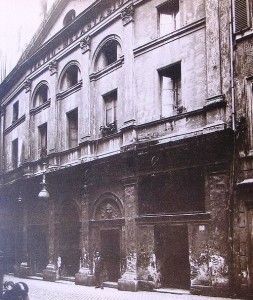The first Real Tennis Society Tour will take place in Italy.
Dates for the first RTS Tour are forthcoming. The Tour is open to members only.
Cees de Bondt (Royal Tennis in Renaissance Italy (2006) and his most recent article “The Apollo and Hyacinth Tennis Theme in Baroque Poetry”, Studi Secenteschi Rivista Annuale , Vol. LIV, Leo S. Olschki Ed. (Firenze, 2013)) will guide us through the streets of Rome following the steps of Cardinals and Artists in the late 16c and early 17c along with an excursion to Tivoli to visit the Villa d’Este’s Tennis Court.
Here is a short piece by Cees to wet the appetite…
Caravaggio & Tennis in Rome
Anyone wishing to reconstruct the life and work of the painter Michelangelo de Merisi da Caravaggio during his dark, final years will have to start on 28 May 1606, when he killed his opponent Ranuccio Tomassoni in a brawl after a tennis (pallacorda) match in Rome. One of Caravaggio’s most reliable biographers, Giovanni Pietro Bellori (1615-1696), gives a brief but colourful description of the 1606 match when he wrote that the painter played gioco di palla a corda with a young friend and that during the match they started hitting each other with their rackets. Eventually Caravaggio drew his sword and killed his opponent. Our residence in Rome, Hotel Adriano, lies in Via di Pallacorda. It is situated only next door to the tennis court (now a garage: Photo below) where Caravaggio and Ranuccio Tomassoni played their match, arguably the most famous in tennis history. Modern Roman guide books never fail to tell us what the origin of the name of this street is and Caravaggio’s involvement in it. It is in the streets around Hotel Adriano, in the Campo Marzio area, that we can trace the painter’s footsteps. Caravaggio lived here from 1604-1605, in the now Vicolo del Divino Amore, where according to the inventory of his possessions he experimented with mirrors to reflect light, creating his characteristic chiaroscuro. As a man of the streets he roamed the area, with its brothels and taverns, so vividly reflected in his paintings. Caravaggio’s residence at Vicolo del Divino Amore just happened to be the time when the Via di Pallacorda tennis court was being built, only separated from the court by Palazzo Firenze, the residence of his principal patron Cardinal Francesco Maria del Monte. Caravaggio must have followed progress on the construction of the tennis court constantly, planning to play there at the first opportunity that presented itself. In 1604 the Dutch biographer Carel van Mander in his Schilder-boeck (Book on Painting) already provided a first glimpse of the painter’s passion for tennis and of his violent nature, when he wrote: “with a sword at his side, and with a servant following him, the painter Caravaggio went from one tennis court to the next, ever ready to engage in a fight or argument, which made him a character very difficult to get along with”. Van Mander’s foresight is remarkable, the fatal 1606 tennis match became the most tormenting event of Caravaggio’s life. For his crime the painter risked capital punishment (bando capitale) and was forced to leave the city, living like a man on the run, never to return to Rome again.
